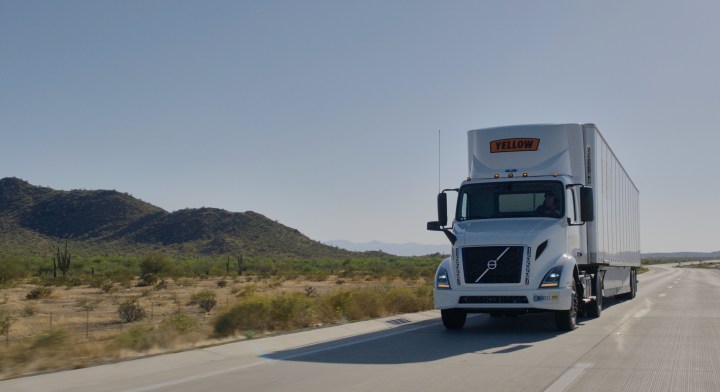
How can trucking companies get more drivers on the road?

The pandemic has affected industries across the board, with rapidly changing consumer habits, supply-chain issues and labor shortages — and the trucking industry is no exception. With many older drivers retiring over the past year, the industry is scrambling to attract new drivers, partly to meet surging demand for transport of goods purchased via e-commerce.
Postings for truck transportation jobs are up 59% compared to January and February 2020, according to a report from logistics company Coyote and analytics firm Emsi. Companies hiring long-haul truckers are especially seeing low success rates when they post jobs.
“COVID has shown Americans really the importance of the trucking profession,” said Darrel Harris, president of Yellow Corp., a trucking company based in Overland Park, Kansas. “Our drivers and dockworkers worked around the clock through the pandemic to get essential goods to homes and businesses across the country.”
Harris spoke to “Marketplace” host Kai Ryssdal about the trucker shortage. The following is an edited transcript of their conversation.
Darrel Harris: Our biggest issue right now is we have a driver shortage. And according to the American Trucking Associations, our industry right now needs an additional 60,000 truck drivers ASAP, and it’s a deficit that’s expected to grow by more than 160,000 by 2028.
Kai Ryssdal: Why do you need so many drivers? Yes, lots of stuff moves on trucks. And yes, there’s pent-up demand. We’ve been talking about that for months now. Why? Why is it so severe right now for your industry?
Harris: Well, what a lot of people may not realize is that 70% of the nation’s freight is carried by commercial trucks, and they’re carrying everything from dishwashers to construction supplies, and of course, all that stuff we like to buy on Amazon. And COVID has shown Americans really the importance of the trucking profession. You know, our drivers and dockworkers worked around the clock through the pandemic to get essential goods to homes and businesses across the country during COVID. And we continue that pace today.
Ryssdal: I read somewhere that, that turnover among truck drivers in this economy is like 90%. First of all, is that right? And second of all, what do you do about that?
Harris: Well, the thing you have to realize in trucking is, you know, all drivers are not created equal, so to speak. You know, we are actually in the less-than-truckload side of the trucking business. And what that means is, our drivers range from city drivers to medium-range drivers. And then of course, we do have what they call long-haul, but it really comes down to the lifestyle that comes along with this space. And in our space, we don’t experience that type of turnover.
Ryssdal: Right. So less-than, less-than-truckload drivers can get home at night. If you’re long-hauling it, though, you’re not going to be able to do that, which certainly makes sense. But if I wanted to get into trucking today, let’s say I’m an ambitious, you know, 25-year-old, I want to be out on the road. How much am I going to make driving a truck?
Harris: Industry average right now is about $55,000 a year. But honestly, we have about 500 folks that made over $100,000 last year.
Ryssdal: Which seems nifty.
Harris: It’s absolutely nifty. And we’re doing everything we can to really educate folks on, you know, the opportunities that exist within trucking.
Ryssdal: Well, tell me a little bit about that, right? Because, as you said, there’s huge demand, we’ve got some turnover in the long-haul space and, and while making $100,000 is nice, it comes with a price — being away from home. So how else are you retaining drivers?
Harris: I’ll be honest. You know, drivers in the industry are aging, many of them with our company for 20, 30, even 40 years, Kai. So, you know, some retirement-age drivers retired during COVID, which is also affecting the shortage. And we’re determining options to keep them on the job at least part time, if they’re interested.

Ryssdal: So what happens if, and you know, there are something like 3½ million truck drivers in this economy, I imagine both less-than-truckload and long-haul, so industrywide, about 3½ million. What happens if, over time, we wind up not having enough people to drive trucks?
Harris: Well, we’re not gonna let that happen. But you know, in the end of the day, we’re doing everything we can to keep drivers in trucks and to start bringing new people into the business.
Ryssdal: I appreciate that you say you’re not gonna let that happen. But there are some things that are out of your control, even though you are the president of this company. And, I do want to know what happens to consumers if somehow we don’t have enough truckers out there.
Harris: Right. Well, I think what you’re going to see is increases in the cost of goods, if that were to occur, and so this is a serious issue. It’s serious for our country, certainly serious for our industry, and it’s one that we’re focused on now more than ever.
There’s a lot happening in the world. Through it all, Marketplace is here for you.
You rely on Marketplace to break down the world’s events and tell you how it affects you in a fact-based, approachable way. We rely on your financial support to keep making that possible.
Your donation today powers the independent journalism that you rely on. For just $5/month, you can help sustain Marketplace so we can keep reporting on the things that matter to you.

















